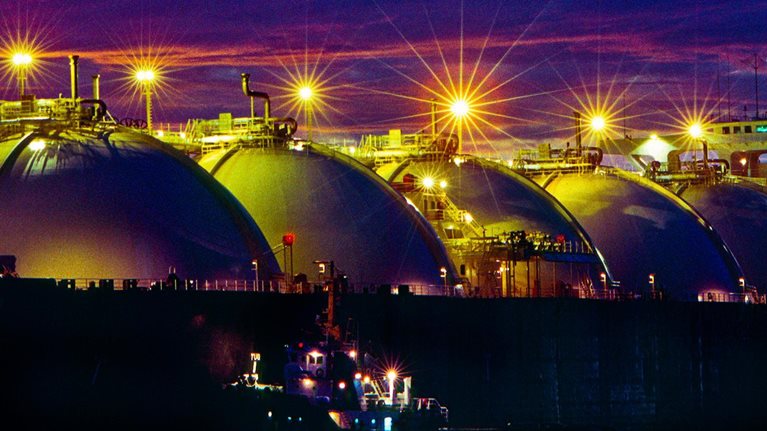Unforeseen events have disrupted the gas market in the last eight years but paradoxically lent it a degree of stability—for the time being, at least. The shale-gas boom in the United States, rapidly increasing Asian demand, and the European economic crisis have driven huge price discrepancies among regional markets. The influence of these three disruptions is not likely to wane before the turn of the decade. But then what?
Enormous value is at stake. Depending on how factors such as Asian demand, oil prices, or North American exports play out, our analysis suggests that value creation in the global gas industry in 2030 could be anywhere between $310 billion and $725 billion, compared with $340 billion in 2011. This $415 billion difference in potential outcomes in a single year suggests very different prospects not only for the industry as a whole but also for different participants, as the value gains will by no means be evenly spread.
Liquefied natural gas (LNG), while only accounting for 10 percent of the global gas market currently, will be a key determinant of market prices and eventual value creation, as it is the only supply source mobile enough to plug supply and demand gaps in international markets. At the moment, it is in short supply. But because uncertainty about future prices has made buyers reluctant to sign new long-term contracts under traditional terms that link gas prices to oil prices, developers of gas reserves outside North America have been hesitant to sanction new LNG facilities, particularly as LNG project costs are rising rapidly.
This may seem prudent in the face of so much uncertainty. But by doing nothing, LNG developers risk forgoing future profitable supply opportunities, and LNG buyers risk extending the current supply shortage. While there is no denying the challenges that uncertainty poses in the industry, those most likely to prosper will be the participants that understand the uncertainties, anticipate market developments, and build robust strategies capable of adapting to what the future holds.
Discontinuities upending the market
Over the past decade, regional gas markets have become much more connected, with the number of LNG or pipe routes carrying over five billion cubic meters per annum (bcma)—more than doubling between 2001 and 2011. Yet despite increased linkages, gas prices in regional markets have diverged (Exhibit 1). Three market disruptions explain this.
Regional gas prices have diverged.

In North America, rapid growth in shale-gas production has led to four years of oversupply and plummeting gas prices. Between 2008 and 2012, production grew at an annual compound rate of 29 percent. However, gas demand failed to keep pace as consumers were slow to switch from other fuels, energy-efficiency measures offset demand growth, and exports have not been an option, since it can take five years to build an LNG export terminal and acquire the necessary permits. Consequently, gas prices in North America fell from $8.9 per million British thermal units (MMBtu) to $2.8 per MMBtu over the same period.
In Asia, LNG prices have been boosted by economic growth, coupled with Japan’s decision in 2011 to shut down its nuclear capacity following the Fukushima disaster. Japanese gas demand grew by more than 20 percent between 2010 and 2012, from 95 bcma to 117 bcma. As Japan has no domestic gas, this all had to be imported as LNG.
Finally, in Europe, an economic slowdown—combined with energy-efficiency improvements and the availability of cheap coal—contributed to an annual decline in gas demand of 1.6 percent between 2005 and 2012. This is in marked contrast to annual growth of 2.7 percent over the previous 15 years. At the same time, liquidity on traded gas markets rose as buyers who found they had contracted excess capacity sought to sell it on. As a result, prices in Europe have fallen, breaking the traditional link with oil prices.
Getting to grips with longer-term uncertainty
The impact of all three developments is likely to persist in the medium term (see sidebar “Why supply will likely remain tight this decade”). But the longer-term outlook is far less clear. Four factors will be major drivers of future market dynamics and prices.
The pace and volume of North American LNG exports
North American gas developers are eager to export their plentiful supply of cheap LNG to higher-priced markets. By the end of 2013, they had applied for export permits for more than 380 bcma—equivalent to all of the world’s current liquefaction capacity. If even one-third of this capacity were built, it would have a significant impact on global LNG prices, threatening the viability of higher-cost capacity additions in countries such as Australia and Russia and in Africa, as shown in Exhibit 2. North American exports could be highly profitable at recent LNG prices of $18 per MMBtu but could still turn a profit even if they fell to as low as $12 per MMBtu.1
Increased LNG exports from North America would outcompete high-cost supplies.

There is uncertainty about just how much export capacity will get built for three reasons. First, it is unclear to what extent export permits will be granted, as the US government may choose to shield the domestic economy from the higher gas prices that could result from large-scale LNG exports. (Some 90 percent of planned North American export capacity is in the United States; only 10 percent is in Canada.) Permits for 80 bcma have been granted to date, but the government has not yet indicated whether it will allow further capacity to be exported.
Second, even if more LNG exports were permitted, it is uncertain to what extent demand would match potential supply. In Europe, North piped gas imports. In South Korea and Japan, a large share of LNG demand is covered by contracts that extend beyond 2030. And potential importers of any nationality may choose to limit the proportion of North American LNG they import given concerns about overdependence on any single supplier.
Third, even if more exports were permitted and matched by demand, there is a risk that the investment required to deliver so much new liquefaction capacity would push up costs to a point where they would become uncompetitive with LNG production elsewhere.
Demand growth for LNG in Asia
Asia’s fast-growing economies will be the main drivers of growth in global gas demand in the next decade. Forecasts from the International Energy Agency show demand in Asian countries that are not part of the Organisation for Economic Co-operation and Development growing by 4.5 percent a year between 2010 and 2035. This implies that this group of 11 countries, which includes China, India, and Indonesia, would see demand rise from 350 bcma in 2012 to 870 bcma in 2030, accounting for more than one-third of total global growth in gas demand in that period. 2
Yet long-term forecasts of Asian demand are uncertain, dependent as they are on economic growth, new infrastructure to link coastal supplies with inland customers, and the development of markets for gas as a transport fuel. Our analysis suggests gas demand in 2030 could be as low as 660 bcma if economic growth disappoints and infrastructure buildout is slow, or it could reach as much as 1,120 bcma if growth is strong, infrastructure plentiful, and gas widely adopted as a transport fuel.
How much of Asian gas-demand growth will need to be supplied by LNG imports is highly dependent on the extent to which China becomes able to meet its own needs through development of its shale-gas reserves. Development is still at an early stage, and production in China is unlikely to increase as rapidly as it did in the United States, as China has less subsurface data available. This will extend the time needed to explore, appraise, and develop reserves. Moreover, the shale identified so far is deeper underground than in the United States (four to six kilometers, as opposed to two to four kilometers) and located in sites with difficult terrain that are often highly populated.
The Chinese government has set a target for shale-gas production of between 60 bcma and 100 bcma by 2020.
LNG supply from Australia, East Africa, Middle East, and Russia
Australia, East Africa, the Middle East, and Russia have some of the largest gas resources available for supply after North America. Our projections suggest they could potentially supply almost 280 bcma by 2030. But here, too, actual supply and the extent to which it would affect global markets is uncertain. Future Australian and Russian LNG projects face high costs and therefore depend on Asian LNG prices remaining high in order to be commercially viable. Meanwhile, gas-resource holders in East Africa are seeking long-term contracts linked to the current high price of oil before committing to new LNG facilities. As mentioned, few buyers are willing to commit to these terms today.
There is also longer-term uncertainty about the behavior of lower-cost producers in the Middle East, which have the potential to supply large amounts of gas to China, India, and Southeast Asia. To date, however, Qatar’s moratorium on further gas exports, strong domestic-demand growth in Saudi Arabia, and Iran’s political isolation have meant these opportunities have gone unexploited. But things can change.
The price of oil
More than 75 percent of all Asian gas imports are priced at levels contractually linked to oil prices. Future oil prices are inherently uncertain, dependent as they are on factors such as technological developments, global economic growth, and the pricing strategies and discipline of Organization of Petroleum Exporting Countries producers. If oil prices fall, Asian gas prices could drop toward the cost of North American gas deliveries to Asia. Lower oil prices would also reduce the cost of gas production and liquefaction as the market to supply goods and services to oil and gas producers would also loosen.
Future industry value differs by as much as $415 billion
To assess the potential impact of these uncertainties, we modeled four scenarios. They do not presume to predict the future. What they show quite clearly, however, is how four plausible futures yield very different values, and how those values are distributed differently.
The scenarios start from four different assumptions: that current trends continue (our base case), that there are no constraints on North American LNG exports, that there is a surge in Asian LNG demand, and that the price of oil drops.3 To create each scenario, we combine these starting points with reasonable assumptions about how other current uncertainties might play out. For example, if North American LNG export capacity were to grow rapidly—reaching 180 bcma in 2030—what would this say about export capacity from other suppliers? The sidebar, “What the four scenarios cover” describes in detail these scenarios and the assumptions upon which they are based.
Exhibit 3 shows the level of value created by region under each scenario in 2030, based on the trade flows and price movements that ensue.4 The gap between the scenarios with the least and greatest value creation is as much as $415 billion. Value creation will also differ by country. By way of illustration, Exhibit 4 shows the implications for value creation within and and among individual countries in the different scenarios.
Value creation varies by region under different scenarios.

The value created in domestic markets and through LNG and piped flows varies under different scenarios.

There are implications for companies, too. We calculated the value of gas exports and sales in local gas markets for four of the world’s largest gas producers under the four scenarios. Their combined value creation ranges from $35 billion to $78 billion, depending on which scenario unfolds.
Strategic implications
For the time being, significant arbitrage opportunities continue to exist for LNG players because of pricing disparities among the United States, Europe, and Asia and because of the big difference in the cost of LNG production in different regions.
But LNG is a long-term business, with long-term contracts and large capital projects that only recoup their costs over two or three decades. To prosper regardless of what the future holds, suppliers and buyers of LNG will need the foresight to predict how the market will evolve. Some supply and demand signposts will be obvious—for example, the granting of a series of new permits for US terminals, or final investment decisions for new LNG projects in Africa and Australia. Less obvious demand indicators might be the number of new LNG filling stations in Asia or the extent of the development of gas-pipeline networks there. Companies will therefore need to keep a close watch on local market developments and hone the ability to correctly interpret what they presage.
LNG buyers are in a powerful market position. Because currently proposed LNG supply capacity is likely to far exceed demand, buyers will be able to choose from a wide range of competing suppliers. This creates an opportunity to negotiate terms with developers of new facilities that may be eager to lock in customers ahead of competitors. In the previous buyers’ market ten years ago, buyers willing to commit to long-term contracts were able to secure attractive terms. Choosing the right suppliers can be a complex task, however, and LNG buyers will need to strengthen their sourcing capabilities in order to evaluate what will become a much broader range of options and negotiate keen terms.
And what of suppliers? In all four scenarios, new LNG projects outside North America are required to meet demand, yet few are currently progressing. Every year of delay could carry significant costs given the likelihood that prices will stay high until around 2020, but thereafter only under the “Asian demand surge” scenario will such high prices continue. Developers might therefore consider offering lower prices or more flexible terms to anchor customers now. To do so, they will need to be skilled at identifying markets where profits lie and at setting commercial terms that attract buyers without giving away too much value.
When the outlook does become clearer, suppliers will need the ability to respond rapidly. Securing a range of options now will help. Options could include forming partnerships with Asian gas buyers to guarantee a share of the Asian market—particularly important if demand growth is at the lower end of expectations—or participating in marginal LNG projects that can be developed quickly when market conditions are right. Companies will also have to learn to develop facilities more quickly, bringing them on stream rapidly once enough information is available to make an investment decision. The Yamal LNG project in Russia, sanctioned in December 2013, shows the way. It is challenging the five-year development norm by aiming to ship its first cargo in 2017. New floating LNG technologies, which liquefy gas at sea close to the resource, may help compress development times still further.
Finally, cost efficiency could prove crucial if higher-cost developers are to remain competitive. Significant reductions can be captured in the delivered cost of LNG through project optimization, increased industry collaboration, and improved labor productivity.5
The gas market’s precise future is unclear. The fact that huge value is at stake is not. LNG suppliers and buyers cannot afford to wait for absolute clarity before preparing for the future. Understanding just how much value is at stake may help embolden them.



